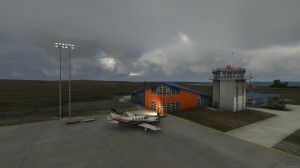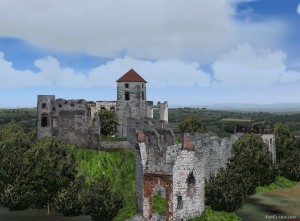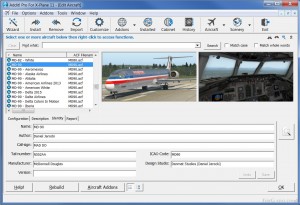Complete Aircraft with Virtual Cockpit
FSX FS2004 Curtiss P40E P40F. The P-40 is notable for having served in every single front of World War II. It proved very successful on all fronts, and some of the highest scoring USAAF fighter units of the war flew the P-40 for most of the conflict. The 325th FG, better known as the Checkertail Clan, is one of the most well-known Fighter Groups to have fought in the Mediterranean Theater of Operations (MTO). While flying the P-40, the 325th and its three squadrons is credited with at least 130 air-to-air kills while flying the P-40 from April to October of 1943. The 57th Fighter Group, which also operated in the MTO, also flew the P-40, only for a much longer period of time. The Curtiss fighter equipped the 57th from October of 1942, all the way until early 1944, during which time they we
Show more... re credited with at least 140 air-to-air kills. It was the 57th that took part in the famed Palm Sunday Massacre which took place on April 18, 1943. On this day, the three squadrons of the 57th, one squadron from the 324th Fighter Group (also flying P-40s) and a small group of British Spitfires, intercepted a large formation of German transport planes (Ju-52) and their escorts (Bf-109). After it was all said and done, at least 70 German planes had been shot down, with roughly 6 or 7 Allied airplanes being downed. The P-40s success was not limited to the MTO though, for the Warhawk also proved its mettle during battles in the Pacific War. The 23rd Fighter Group, which took over from the famed Flying Tigers after they disbanded, continued to fly P-40s (of newer models) and racked up some of the highest kill-to-loss ratios of any Fighter Group in the war. The Royal New Zealand Air Force also used the P-40 to rack up some impressive air-to-air kills over the Japanese during intense fighting in the South Pacific throughout 1942 into 1944. The Russians also used the P-40 quite extensively against the Germans on the Eastern front, where the Warhawk provided good close air support as well as good air-to-air combat performance, with many Russian pilots becoming aces on the P-40 (although not as many as on the P-39 Airacobra, which was the most popular American fighter with the Russians). Often overlooked by many so-called historians, the P-40 was, in reality, one of the most successful fighters of the war. It was excellent as a fighter-bomber, and it could more than hold its own in air-to-air combat against the Axis fighters it encountered. The P-40 was used by over two dozen countries during and after the war. The last P-40s in military service were serving with the Brazilian Air Force (FAB) when they were finally retired as late as 1958! -The P-40E or Kittyhawk I had a slightly more powerful engine than the Tomahawk and the nose guns were replaced by an extra. 50 in gun in each wing. Some aircraft also had small underwing bomb shackles. -P-40F and L, both featured a Packard Merlin engine in place of the normal Allison, and thus did not have the carburateur scoop on top of the nose. Performance for these models at higher altitudes was better than their Allison-engined cousins. The L in some cases also featured a fillet in front of the vertical stabilizer, or a stretched fuselage to compensate for the higher torque. The P-40L was sometimes nicknamed Gypsy Rose Lee, after a famous stripper of the era, due to its lighter weight. -P-40K, an Allison engined P-40L, with the nosetop scoop retained and the Allison configured scoop and cowl flaps. -P-40M, a P-40E had a more powerful Allison engine and minor other improvements. -P-40N, was the final production model. The P-40N featured a stretched rear fuselage to counter the torque of the larger, late-war Allison engine, and the rear deck of the cockpit behind the pilot was cut down at a moderate slant to improve rearward visibility. A great deal of work was also done to try and eliminate excess weight to improve the Warhawks mediocre speed. Early N production blocks dropped a. 50 in (12. 7 mm) gun from each wing, bringing the total back to 4; later production blocks reintroduced it after complaints from units in the field. Despite its lifelong reputation as a mediocre aircraft, it was sturdy, fast in a dive, posessed a respectable rate of roll, was easy to maintain, and was well armed. Of all the aircraft built by the US during WWII, it was the third most-produced. the British Commonwealth alone took 930 aircraft, issuing them to 16 squadrons (including two South African Air Force units) and sending 23 on to serve with the Soviet air force. The Royal Australian Air Force equipped its 3 Squadron, 75 Squadron, 76 Squadron, and 120 Squadron (Netherlands East Indies) with P-40s, 75 and 76 Squadron being instrumental in the defeat of the Japanese at the Battle of Milne Bay. 14, 000 P-40s were produced up to 1944 and they were used by the airforces of twenty-eight nations. It saw the majority of its frontline action in both the China-Burma-India Theater and the Mediterranian Theater with the USAAC and Commonwealth forces, and with the VVS (USSR air force) on the Eastern Front. The VVS also converted some of their Warhawks to domestic Klimov engines for ease of maintinence and repair.
Show less...
Users Reviews
FSX FS2004 Curtiss P40E P40F. Rating: 3.00 of 10 over a total of 1 reviews.
FSX FS2004 Curtiss P40E P40F. Rating: 3.00 of 10 over a total of 1 reviews.
jigglewillyrating: 3
August 25, 2016
Prop is funky looking... not wild about sound either Write a review...









